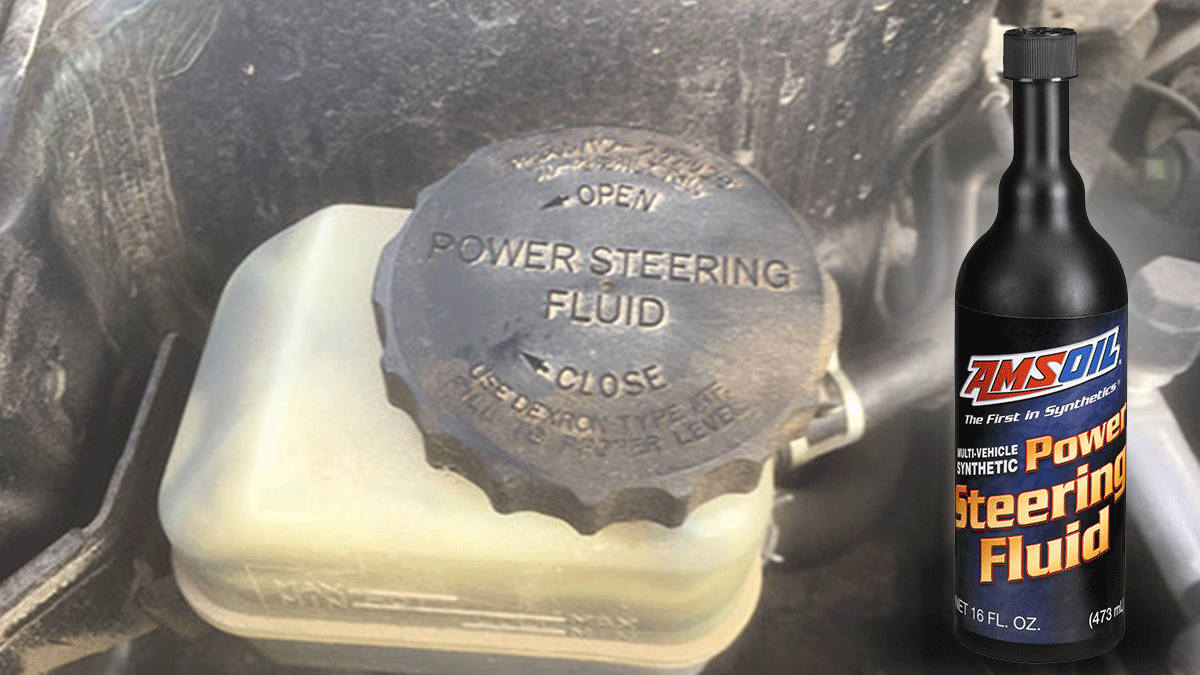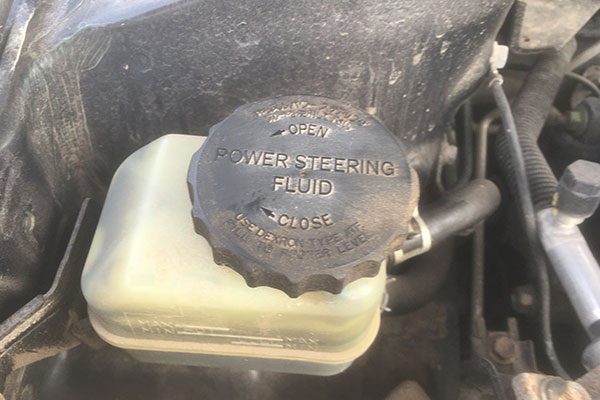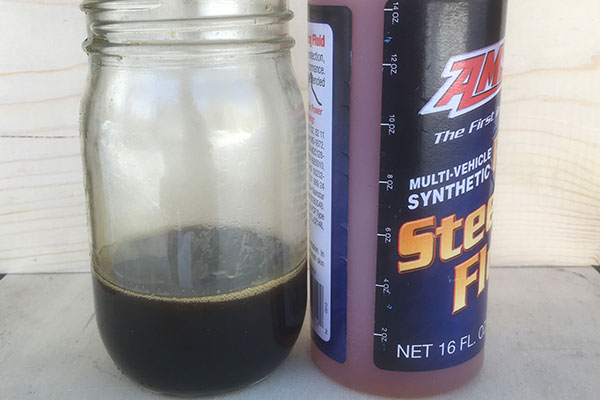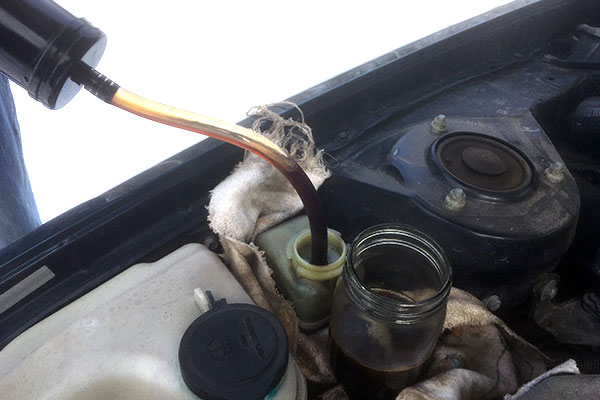Power Steeringfluid Was Low Then Checked Again and It Was Fl
How to Check Power Steering Fluid (and When to Change it)
There are a couple ways to change power steering fluid, depending on your technical know-how.

Checking power steering fluid is a simple task anyone can do. Yet, it's often overlooked until the signs of low power steering fluid emerge, such as the pump whining and making noise. In this post, we'll explain how to check power steering fluid and how to change it.
First, check your owner's manual for recommendations on how often to check power steering fluid.
Since it's so simple, I generally check power steering fluid anytime I check my oil level or before long trips.
Step-By-Step: How To Check Power Steering Fluid
1. Locate The Power Steering Fluid Reservoir
Its location differs for every vehicle. It's usually a small, clear container with a black cap. Many vehicles have marks on the outside of the reservoir to indicate "MAX" or "MIN". Ensure the fluid level is above the "MIN" mark but not overfilled.

The power steering fluid reservoir is typically a clear plastic container near one of the wheels.
2. Check Dipstick (If Equipped)
Other vehicles have marks on the dipstick, similar to an oil dipstick. In this case, remove the cap and wipe the dipstick clean. Reinstall the cap, ensuring it's completely seated.
3. Remove Cap Again And Check Fluid Level
Ensure it's at the appropriate level. You may see marks for "full hot" and "full cold," so ensure you're referencing the correct mark depending on whether the engine is hot or cold.
4. Add Power Steering Fluid
Top-off the reservoir if needed to fill to the appropriate level.
When Do I Change Power Steering Fluid?
Check the owner's manual for recommendations on how often to change power steering fluid.
However, if it's been a while (like, never) and the fluid appears dark and dirty, go ahead and change it.
This image shows the dramatic difference between old and new power steering fluid.

Change power steering fluid once it's become dirty and contaminated. Otherwise, it can lead to pump wear and reduced steering performance.
Like any other lubricant, power steering fluid accumulates wear material, moisture and other debris. The fluid also wears out due to oxidation. Worn out power steering fluid can cause the pump to whine and make noise.
It's a good idea to change power steering fluid before you end up replacing the pump, which is far more expensive.
How Do I Change Power Steering Fluid?
The process differs depending on your vehicle. Check your owner's manual or a service manual for instructions specific to your car or truck.
In general, though, most power-steering systems have the same configuration.
A high-pressure hose carries fluid from the power-steering pump to the steering rack. A low-pressure hose returns the fluid back to the reservoir. The cycle repeats as the engine is running.
Flushing The Power Steering System
Completely flushing the power steering system requires some technical know-how and can be a mess. It's also helpful to have a helper on hand.
- Disconnect the low-pressure return hose and direct it into a bucket or drain pan. You probably will need a length of hose to reach the pan.
- Then, have someone start the engine and turn the steering wheel as far as it goes in both directions. This will pump old fluid into the drain pan.
- To prevent air from entering the system, have a helper near the reservoir with a couple bottles of new power steering fluid. Add fluid as needed to prevent the reservoir from running dry.
- Once your helper sees new fluid draining into the pan, shut off the engine and reconnect the hose.
Avoid allowing air into the system so you don't have to bleed it.
An Easier Way To Change Power Steering Fluid
While flushing the system completely is best, you'll inevitably run into hurdles.
- Rust on the hose clamps will likely prevent removal without breaking them.
- The hose you'll need to disconnect to drain the system will inevitably be buried at the bottom of the engine bay; you may need to recruit Plastic Man to reach it.
- And, of course, you'll likely mess up your garage floor with power steering fluid.
The "Poor Man's" Power Steering Flush
While this procedure won't remove all the old fluid, like flushing the system will, it will remove most of it. And it's much easier and cleaner.

Use a fluid extractor or turkey baster to remove the old power steering fluid from the reservoir. Top it off with new fluid, start the vehicle and turn the wheel from lock to lock a few times. Repeat the process until most of the old fluid is removed.
- Place some rags around the fluid reservoir and place a catch can nearby.
- Using a fluid extraction pump or turkey baster, remove the old fluid and empty it into the catch can. Leave enough fluid in the reservoir to cover the hose inlets. This prevents air from entering the system.
- Add new fluid to the reservoir and run the engine. Turn the wheel from side to side as far as it goes a few times.
- Turn off the engine and repeat the first three steps until the fluid is clean.
You can also drive as normal for a day or two and repeat until you've cycled most of the old fluid through the system.
This simple procedure removes much of the old fluid quickly and easily. I've performed it on a couple different vehicles with good results.

SYNTHETIC VS. CONVENTIONAL
Although you might know that synthetic oils outperform conventional oils, you might not understand why. The differences begin at the molecular level.
Learn More

What Type Of Power Steering Fluid Do I Need?
There are a few power steering fluid types available that may be recommended for your vehicle.
- Automatic Transmission Fluid: Some vehicles specify use of automatic transmission fluid in the power steering system.
- Conventional Power Steering Fluid: These are non-synthetic fluids made using conventional base oils. In general, they won't provide the same level of protection against wear, oxidation and cold-temperature thickening as synthetic fluid.
- Synthetic Power Steering Fluid: Made using synthetic base oils that provide inherently better protection and extreme-temperature performance compared to conventional fluids.
Use a fluid that meets the appropriate specification given in your owner's manual.
For best protection against pump wear and best performance in temperature extremes, use synthetic power steering fluid.
Synthetics promote formation of a strong fluid film to prevent wear. Plus, they flow readily in cold weather to help silence that annoying power-steering-pump whine on frigid mornings.
What Is Power Steering Fluid?
Many vehicles today use electric power steering systems instead of traditional hydraulic systems to help improve fuel economy. Eliminating the belt-driven pump reduces parasitic losses and helps boost mpg.
In hydraulic systems, the power steering fluid is used to transfer energy to help turn the wheels. Without power steering, it'd much more difficult to turn your car's steering wheel – and nearly impossible when the car is stationary.
I once had an old truck that lost its power steering system, and turning the wheel required two hands and a lot of muscle.
So, what is power steering fluid? It's effectively a hydraulic fluid whose primary role is to transfer energy. Although it must protect against wear and oxidation, too.
Low Power Steering Fluid Symptoms
There are a couple telltale signs of low power steering fluid.
- Difficulty Steering: If it takes more effort than normal to turn your steering wheel, low power steering fluid is the first thing to check. Insufficient fluid prevents the system from working properly, which you'll often feel as a stubborn steering wheel.
- Steering Whine: If you hear a loud whining or screeching noise coming from under the hood when you steer, particularly if you turn the wheel as far as it goes, it's likely due to low power steering fluid. Although, it might also be a bad pump.
- Fluid on the Ground: Fluid stains on the garage floor under the reservoir or pump are a bad sign. Top off the reservoir, start the vehicle and have someone turn the wheel back and forth while you locate the source of the leak.
More like this
Source: https://blog.amsoil.com/how-to-check-power-steering-fluid-and-when-to-change-it/
0 Response to "Power Steeringfluid Was Low Then Checked Again and It Was Fl"
Post a Comment